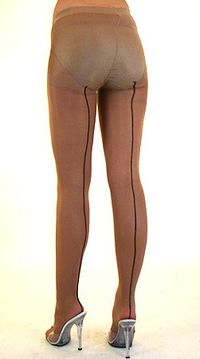Pantyhose
Pantyhose (also called tights in the UK) are sheer, close fitting coverings of the body from the waist to the feet, almost exclusively worn by women. Like stockings, pantyhose are usually made of nylon. The one-piece pantyhose garment appeared in the 1960s and provided a convenient alternative to stockings (nylons).
The term 'pantyhose' originated in the United States, referring to the combination of 'panties' (an American term for women's underpants) with sheer nylon hosiery, meaning they are usually worn without other undergarments. In the United Kingdom, they are called tights, a term that refers to all such garments regardless of whether they are sheer lingerie or sturdy outerwear. In the U.S., the term tights is used for non-sheer garments typically made of a stretchy material like spandex, and worn during exercise or athletic activity, or as utility clothing.
History
In the 1920s the fashionable hemline for women's skirts and dresses began to rise enough to show a woman's legs and sheer hosiery that covered the legs was only available as stockings. They were typically made of silk or artificial silk (now known as rayon), and after 1939 with nylon.
The actress-dancer Ann Miller devised pantyhose in the early 1940s as a solution to the problem of continual torn stockings during the filming of dance production numbers. The common practice had been to sew hosiery to briefs worn by Miller. If torn, these had to be removed and resewn with a new pair. At Miller's request, hosiery was manufactured for her as a single pantyhose. The first attempt was too short for Miller's long legs; the second try got it right.
In 1959, Allen Gant Sr. of Glen Raven Mills introduced pantyhose. Stocking manufacturers began using circular knitting machines to reduce manual labor and create seam-free stockings. In 1965, Glen Raven Mills introduced a seam-free version of pantyhose, which coincided with the introduction of the miniskirt. The miniskirt made it unfashionable to show the tops of a woman's stockings, and by the end of the decade pantyhose had replaced stockings almost entirely. This also contributed to a marked shift in foundation undergarment sales: younger women stopped buying girdles around this time. In the same period hosiery started adding spandex or elastane to give it stretch superior to crimping nylon. Glen Raven Mills still operates in North Carolina, U.S. as Glen Raven Inc.
Starting sometime in the 90s, pantyhose went almost completely out of fashion. Until recently, women, in general no longer wore pantyhose unless it was mandated by dress code, typically found at corporate companies and executive level. An exception to this was the wearing of special pantyhose such as fishnet or various pattern types, but this was a rather rare occurrence.
However, in the mid-to-late '00s of this century, pantyhose have been appearing once again in fashion and in public, indicating the recurring cycle of couture once again bringing the leg covering back into vogue, especially in the form of thicker, dark tights and shades of black pantyhose. Pantyhose have even made a return to Paris runways and Haute Couture
Advantages of pantyhose
On mildly or moderately cold days, pantyhose help keep the legs warm for those wearing skirts or dresses. Above all, pantyhose hides blemishes, bruises, scars on the legs, leg hair stubble, and varicose veins. On cold dry days, pantyhose can help prevent the legs from becoming too dry. Some companies regard wearing skirts or shorts without pantyhose as unprofessional and thus require people who wear skirts or shorts to work to also wear pantyhose or sheer tights (UK).
Dark pantyhose, and black pantyhose in particular, can create the illusion of slimmer legs. Another flip side depends on the wearer's skin tone - dark hose shows runs when worn over light skin, whilst lighter hose show water spots flipped up from the heel after walking in the rain. Whilst, as detailed below, the material is not absorbent, it is quick drying (for example after walking in the rain/being puddle splashed and soaked by a car.
Support hosiery can be worn to support the leg. Regulating blood circulation in the legs, it helps those who work on their feet with preventing/helping varicose veins and resolving pain in the back and legs.
Disadvantages of pantyhose
The nylon fabric of pantyhose is extremely prone to runs (called laddering in the United Kingdom). The wearer can even cause a run in the hose by catching the toenail of her big toe in the fabric when she puts the hose on, by catching it on a desk, car, and by numerous other 'risks'. Some women use clear nail polish to prevent runs from growing.
Unlike cotton, nylon is not an absorbent material. As a result, perspiration from the wearer's feet is more likely to remain in contact with the feet, which may feel unpleasant to her, unless she choses a hosiery product which has silver in it. The silver helps to prevent odour and sweating of the feet, thus making the wearing of hosiery a more pleasant experience. Wearing natural fibre silk stockings and tights is another means of reducing perspiration and keeping the feet feeling fresh all day.
See also Pantyhose fetishism
External links
| This article is about Lingerie and undergarments Main article and index is at Lingerie |
Chat rooms • What links here • Copyright info • Contact information • Category:Root
